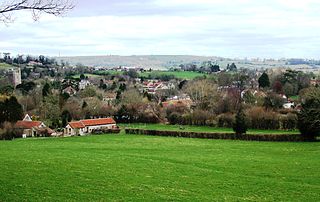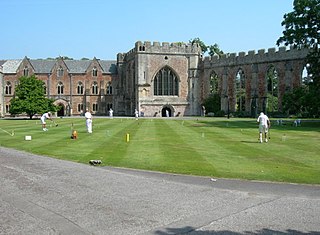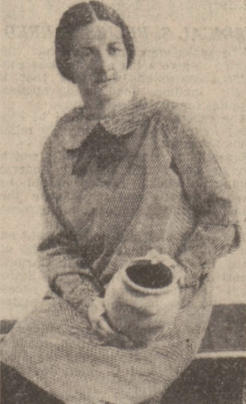
The Royal Crescent is a row of 30 terraced houses laid out in a sweeping crescent in the city of Bath, England. Designed by the architect John Wood, the Younger, and built between 1767 and 1774, it is among the greatest examples of Georgian architecture to be found in the United Kingdom and is a Grade I listed building. Although some changes have been made to the various interiors over the years, the Georgian stone facade remains much as it was when first built.

Chew Magna is a village and civil parish within the Chew Valley in the unitary authority of Bath and North East Somerset, in the ceremonial county of Somerset, England. The parish has a population of 1,149.

Longleat is an English stately home and the seat of the Marquesses of Bath. A leading and early example of the Elizabethan prodigy house, it is adjacent to the village of Horningsham and near the towns of Warminster and Westbury in Wiltshire, and Frome in Somerset.

Chew Stoke is a small village and civil parish in the affluent Chew Valley, in Somerset, England, about 8 miles (13 km) south of Bristol and 10 miles north of Wells. It is at the northern edge of the Mendip Hills, a region designated by the United Kingdom as an Area of Outstanding Natural Beauty, and is within the Bristol/Bath green belt. The parish includes the hamlet of Breach Hill, which is approximately 2 miles (3.2 km) southwest of Chew Stoke itself.

Box is a large village and civil parish within the Cotswolds Area of Outstanding Natural Beauty in Wiltshire, England, about 3 miles (5 km) west of Corsham and 5 miles (8 km) northeast of Bath. Box also falls in the easternmost part of the Avon Green Belt. Besides the village of Box, the parish includes the villages of Ashley and Box Hill; Hazelbury manor; and the hamlets of Alcombe, Blue Vein, Chapel Plaister, Ditteridge, Henley, Kingsdown, Middlehill, and Wadswick. To the east the parish includes much of Rudloe, formerly a hamlet but now a housing estate, and the defence establishments and related businesses on the site of the former RAF Rudloe Manor.

The Royal United Hospital (RUH) is a major acute-care hospital in the Weston suburb of Bath, England, which lies approximately 1.5 miles (2.4 km) west of the city centre. The hospital has 565 beds and occupies a 52 acres (21 ha) site. It is the area's major accident and emergency hospital, with a helicopter landing point on the adjacent Lansdown Cricket Club field. The hospital is operated by the Royal United Hospitals Bath NHS Foundation Trust.

Fulneck Moravian Settlement is a village in Pudsey in the City of Leeds metropolitan borough, West Yorkshire, England. The village lies on a hillside overlooking a deep valley. Pudsey Beck flows along the bottom of the valley.

Saltford is a large English village and civil parish in the Bath and North East Somerset unitary authority, Somerset. It lies between the cities of Bristol and Bath, and adjoins Keynsham on the same route. Saltford Manor House claims to be the oldest continuously occupied dwelling in England.

The Bishop's Palace and accompanying Bishops House at Wells in the English county of Somerset, is adjacent to Wells Cathedral and has been the home of the Bishops of the Diocese of Bath and Wells for 800 years. It has been designated by English Heritage as a Grade I listed building.

Lyford is a village and civil parish on the River Ock about 4 miles (6.4 km) north of Wantage. Historically it was part of the ecclesiastical parish of Hanney. Lyford was part of Berkshire until the 1974 boundary changes transferred the Vale of White Horse to Oxfordshire. The 2001 Census recorded the parish's population as 44. Lyford's toponym refers to a former ford the Ock, now replaced with a bridge on the road to Charney Bassett. "Ly" is derived from the Old English lin, meaning "flax". In 1034 it was recorded as Linford.

The Church of St Andrew in Chew Magna, Somerset, England dates from the 12th century with a large 15th-century pinnacled sandstone tower, a Norman font and a rood screen that is the full width of the church. It is a Grade I listed building.

Milsom Street in Bath, Somerset, England was built in 1762 by Thomas Lightholder. The buildings were originally grand town houses, but most are now used as shops, offices and banks. Most have three storeys with mansard roofs and Corinthian columns.

Richmond Royal Hospital, on Kew Foot Road in Richmond, London, England, is a mental health facility operated by South West London and St George's Mental Health NHS Trust, which has its headquarters at Springfield Hospital in Tooting. The hospital's original block is Grade II listed.

Bath and North East Somerset is a unitary authority created on 1 April 1996, following the abolition of the County of Avon, which had existed since 1974. Part of the ceremonial county of Somerset, Bath and North East Somerset occupies an area of 220 square miles (570 km2), two-thirds of which is green belt. It stretches from the outskirts of Bristol, south into the Mendip Hills and east to the southern Cotswold Hills and Wiltshire border. The city of Bath is the principal settlement in the district, but BANES also covers Keynsham, Midsomer Norton, Radstock and the Chew Valley. The area has a population of 170,000, about half of whom live in Bath, making it 12 times more densely populated than the rest of the area.

Queen Anne’s Gate is a street in Westminster, London. Many of the buildings are Grade I listed, known for their Queen Anne architecture. Simon Bradley and Nikolaus Pevsner described the Gate’s early 18th century houses as “the best of their kind in London.” The street’s proximity to the Palace of Westminster made it a popular residential area for politicians; Lord Palmerston was born at No. 20 while Sir Edward Grey and Lord Haldane, prominent members of H. H. Asquith’s Cabinet, were near neighbours at Nos. 3 and 28 respectively. Other prominent residents included the philosopher John Stuart Mill at No. 40, Mansfield Smith-Cumming, the founder of MI6 at No. 21, and Admiral “Jacky” Fisher at No. 16.
Waldo Sullivan Lanchester was a British puppeteer who founded the Lanchester Marionettes (1935–1962), a puppet theatre that was based in Malvern, and later in Stratford-upon-Avon. He wrote a book on the revival of puppeteering and commissioned George Bernard Shaw to write his last completed play Shakes versus Shav in 1949. In 1952, Donald W. Seager wrote that "Waldo Lanchester has consistently been associated with all that is best in the puppet theatre." Archibald Henderson called him "England's greatest puppetmaster."
The Lanchester Marionettes, a professional puppet theatre, was co-founded in 1936 by Waldo and Muriel Lanchester. The 50-seat Lanchester Marionettes Theatre in Malvern, Worcestershire, England was “the only theatre in the country exclusively to be used for marionettes.” George Bernard Shaw’s final play, Shakes versus Shav, was written for the Lanchester Marionettes in 1949.

St Michael and All Angels is a Grade II* listed Church of England parish church in Bedford Park, Chiswick. It was designed by the architect Norman Shaw, who built some of the houses in that area. The church was consecrated in 1880. It is constructed in what has been described both as British Queen Anne Revival style and as Perpendicular Gothic style modified with English domestic features. Its services are Anglo-Catholic.

Mells War Memorial is a First World War memorial by Sir Edwin Lutyens in the village of Mells in the Mendip Hills of Somerset, south-western England. Unveiled in 1921, the memorial is one of multiple buildings and structures Lutyens designed in Mells. His friendship with two prominent families in the area, the Horners and the Asquiths, led to a series of commissions; among his other works in the village are memorials to two sons—one from each family—killed in the war. Lutyens toured the village with local dignitaries in search of a suitable site for the war memorial, after which he was prompted to remark "all their young men were killed".

Muriel Lanchester was a British ceramicist and co-founder of the puppet theatre company, the Lanchester Marionettes. Lanchester and her husband, Waldo were the first British people to appear on French television, as part of the World's Fair in Paris in 1937. George Bernard Shaw’s final play, Shakes versus Shav, was written for the Lanchester Marionettes in 1949.





















